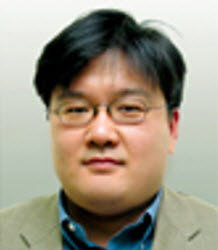
Professor Park Yun
Professor PARK Yun (Department of Physics and Astronomy) and Postdoctoral Researcher KIM Young Duck (Department of Physics and Astronomy) have confirmed that only 0.3-nanometer-thick graphene can spontaneously emit diverse colors of light if floated over the air like a filament in a light bulb. It is the thinnest graphene that has ever made for light emission. Graphene, called the ‘new dream material’, has recently come into the spotlight for its high conductivity, thermal conduction rate, and even flexibility and transparency, which opens up new opportunities for research and numerous applications. When materials gain energy, the energy of electrons inside of them can be transformed into light or heat. However graphene can convert ‘transformed heat energy’ to light again, which makes it possible to emit brighter light. The only problem was that the circuit which is used to hold graphene tightly hinders the conversion process by consuming most of the heat energy. The research team confirmed that graphene that receives high voltage emits bright visible light with 3,000 Kelvin (2,727 Celsius) when floated in the air instead of using attached circuits. They also showed that the color of the light can be changed by adjusting the distance between the graphene and circuit, which is used to reflect the light from the graphene.
- The details of this development were published online in the June 2015 issue of the journal Nature Nanotechnology
- Professor Yun PARK’s lab: http://ydplab.snu.ac.kr
- SNU Department of Physics and Astronomy: http://phya.snu.ac.kr
Written by CHUNG Taejoong, SNU English Editor, tijay@snu.ac.kr
Proofread by Melora Brett Briana Johnson, morningcalm2@gmail.com

